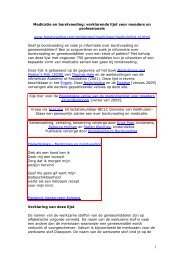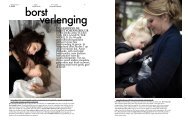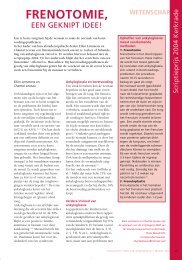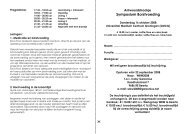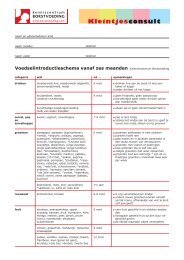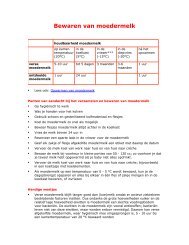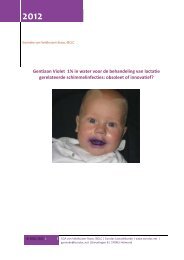Stille ondervoeding aan de borst: hoe bestaat het? - Borstvoeding.com
Stille ondervoeding aan de borst: hoe bestaat het? - Borstvoeding.com
Stille ondervoeding aan de borst: hoe bestaat het? - Borstvoeding.com
You also want an ePaper? Increase the reach of your titles
YUMPU automatically turns print PDFs into web optimized ePapers that Google loves.
<strong>Stille</strong> <strong>on<strong>de</strong>rvoeding</strong> <strong>aan</strong><br />
<strong>de</strong> <strong>borst</strong>: <strong>hoe</strong> <strong>bestaat</strong> <strong>het</strong>?<br />
Rolf Pelleboer<br />
Kin<strong>de</strong>rgastro-enteroloog enteroloog<br />
Catharina-ziekenhuis Eindhoven
(Hypernatraemic) <strong>de</strong>hydration and<br />
malnutrition in fully breastfed<br />
infants in the Netherlands<br />
Rolf Pelleboer, pediatric gastro-enterologist and San<strong>de</strong>r Bontemps,<br />
registrar Pediatrics, Catharina-hospital hospital Eindhoven (at present:<br />
Maastricht)<br />
Rob Pereira and Ko van Wouwe, pediatricians, and Paula van<br />
Dommelen, Paul Verkerk, TNO Qualityof Life, Lei<strong>de</strong>n, the<br />
Netherlands
Overzicht<br />
• 1. Casus<br />
• 2. Studie stille <strong>on<strong>de</strong>rvoeding</strong> <strong>aan</strong> <strong>de</strong> <strong>borst</strong> via <strong>de</strong><br />
NSCK<br />
• 3. Conclusies
Prevalence of breastfeeding in the Netherlands<br />
Years<br />
Day1<br />
3 Months 6 Months<br />
1996 70% 17% 6%<br />
2001 80% 35% 17%<br />
2005 79% 35% 25%
Birth rates in the Netherlands<br />
• 2003: 200.000 births<br />
• 2004: 194.000 births<br />
• 2005: 187.000 births<br />
• (2006: 185.000)
DB, meisje, geb. 270304<br />
• Moe<strong>de</strong>r G 1 P 0, russische, hoog opgeleid<br />
• Vanaf 33e week zwsch in NL<br />
• Zwsch onge<strong>com</strong>pliceerd<br />
• Poliklinische partus in ons ziekenhuis<br />
• Via verloskundige, geb.gew. 3325 gram<br />
• AS 9-10<br />
• < 1 uur pp <strong>aan</strong>gelegd
• Op 4-5-04 gezien op SEH ivm. ernstige<br />
<strong>on<strong>de</strong>rvoeding</strong><br />
• Gew. 2650 gr., - 675 gr. ( 20% gew. verlies)<br />
• Moe<strong>de</strong>r gaf dag en nacht BV<br />
• Moe<strong>de</strong>r had er veel over gelezen
• Eerste week pp: geen problemen<br />
• Later navraag: gew. op dag 10: 3100 gr.<br />
• Babywas vrij rustig, huil<strong>de</strong> niet abnormaal veel<br />
• Consult ha. 3 wk. pp ivm slecht groeien: ha. was<br />
tevre<strong>de</strong>n<br />
• Bij 5 wk. eerste contact CB: 2650 gr.
Lichamelijk on<strong>de</strong>rzoek:<br />
• Zeer ernstig on<strong>de</strong>rvoed kind<br />
• Zeer bleek<br />
• Ingevallen fontanel<br />
• Vitale parameters stabiel<br />
• Lever en milt niet palpabel<br />
• Gespannen neonaat met hoge tonus
Aanvullend on<strong>de</strong>rzoek:<br />
• Hb 9,3 mmol/l; leuco’s 6,6/nl; thr. N<br />
• CRP < 6 mg/l; gluc. 4.8 mmol/l<br />
• ASAT 454, ALAT 326, LD 917, AF 269 u/l<br />
• pH 7,40; Na 138; K 4,9; Cl 105 mmol/l
Aanvullend on<strong>de</strong>rzoek:<br />
• Veel lab naar oorzaak verhoog<strong>de</strong> transaminasen:<br />
alles neg.<br />
• Echo abdomen: geen afw.<br />
• Zweettest 2 x mislukt<br />
• X Thorax geen afw.
Conclusie:<br />
• Ernstige SOB met fors afwijken<strong>de</strong><br />
transaminasen ( geduid als passend bij<br />
<strong>on<strong>de</strong>rvoeding</strong>) bij Russische primipara
Behan<strong>de</strong>ling:<br />
• Voor en na BV wegen: er kwam heel weinig BV<br />
• Bijvoeding bij BV: gew. vloog omhoog<br />
• ( 330 gr. in eerste week)<br />
• Transaminasen daal<strong>de</strong>n fraai<br />
• Vi<strong>de</strong>o interactie begeleiding<br />
• Ontslag 20 mei: gew. 3290 gr<br />
• Eerste weken na ontslag: BV en FV bijvoeding<br />
• Op 2 aug: ( 4 ½ m<strong>aan</strong>d) 6 kg., 62,5 cm .<br />
• Goe<strong>de</strong> tonus en prima ontwikkeling
Objective:<br />
• To establish the inci<strong>de</strong>nce of malnutrition/<br />
(hypernatremic) <strong>de</strong>hydration in fullybreastfed<br />
infants in admitted children in the Netherlands
Inclusion criteria(1)<br />
• Everybabywith insufficient amount of breast<br />
feeding but who doesn’t cry(is quiet)<br />
• Veryfast weight gain through extra feeding with<br />
weighing before and after breastfeeding or<br />
measuring the amount of milk through<br />
expressed breast milk<br />
• Clear (and often impressive) un<strong>de</strong>rnutrition;<br />
weight after f.i. 1 month still un<strong>de</strong>r birth weight<br />
(failure to thrive)
Inclusion criteria (2) : 2 types<br />
• In the first 2 weeks: not enough fluid (with<br />
the risk of f.i. hypernatraemia)<br />
• > 2 weeks: not enough calories (failure to<br />
thrive)
Case <strong>de</strong>finition<br />
• Everybabyadmitted in the hospital within<br />
the first 3 months of life exclusively<br />
breastfed with (hypernatraemic)<br />
<strong>de</strong>hydration or malnutrition (FTT) who<br />
seemed satisfied<br />
• Exclusion: UTI, bronchiolitis, much crying,<br />
diarr<strong>hoe</strong>a, etc.
Methods<br />
• From mid 2003 till mid 2005 we did a<br />
surveillance studyin the Netherlands through<br />
the Dutch Pediatric Surveillance Unit amongst<br />
all Dutch pediatricians<br />
• This is the first prospective orientating study<br />
worldwi<strong>de</strong> as far as we know
Characteristics of Dutch infants up to 3 months old<br />
admitted for <strong>de</strong>hydration or un<strong>de</strong>rnutrition over a 2-year<br />
period<br />
Reported cases<br />
250 (n)<br />
Other diagnosis/outpatient<br />
81<br />
Age > 3 months<br />
9<br />
Insufficient data<br />
2<br />
Cases analysed<br />
Boys/Girls<br />
First born<br />
158 (n) 100<br />
(%)<br />
77 / 78<br />
58<br />
50 / 50<br />
37
History<br />
Home <strong>de</strong>livery<br />
Hospital <strong>de</strong>livery: natural birth<br />
Hospital <strong>de</strong>livery: forcipal /vacuum<br />
/caesarean<br />
Age of mother, mean ± sd<br />
Pregnancy duration, mean ± sd<br />
APGAR score after 5 min, mean ± sd<br />
Birth weight, mean ± sd<br />
Weight loss at admission, median<br />
Weight loss >10.0% / >12.0% / 15.0%<br />
Previous pediatric consultation<br />
158 (n) %<br />
58<br />
66<br />
1 / 13 / 17<br />
30.9 ± 4.6 year<br />
39.1 ± 1.6 wk<br />
9.3 ± 0.9<br />
3.433 ± 578 g<br />
6.8 %<br />
54 / 25 / 7<br />
35<br />
37<br />
42<br />
Inci<strong>de</strong>nce rates of Dutch infants admitted<br />
for <strong>de</strong>hydration while breastfed<br />
Inci<strong>de</strong>nce rate in infants up to 3 months old<br />
per year<br />
per 100,000 breastfed<br />
infants<br />
Clinical scored <strong>de</strong>hydration / in first born<br />
infants<br />
Presumed hypernatraemic <strong>de</strong>hydration<br />
Laboratory documented hypernatraemic<br />
<strong>de</strong>hydration<br />
Inci<strong>de</strong>nce rate in infants up to 1 month old<br />
Clinical scored <strong>de</strong>hydration<br />
Inci<strong>de</strong>nce rate in infants up to ≤ 11 days old<br />
Clinical scored <strong>de</strong>hydration<br />
58 / 46<br />
20<br />
2<br />
55<br />
40
Clinical characteristics of Dutch infants up to 3 months old<br />
admitted for <strong>de</strong>hydration over a 2-year period<br />
Lactation interventions<br />
158 (n) 100 (%)<br />
Use of a breast pump at home<br />
49<br />
31<br />
Use of a breast pump at the<br />
hospital<br />
Lactation consultant available at<br />
the hospital<br />
129<br />
116<br />
82<br />
73
Symptoms at admission<br />
158 (n) %<br />
Age at admission, modus / median<br />
Ina<strong>de</strong>quate growth<br />
Insufficient volume intake<br />
Classical <strong>de</strong>hydration signs<br />
Lethargy<br />
Jaundice<br />
Clinical response to fluid<br />
Signs of shock or seizures<br />
Ina<strong>de</strong>quate body temperature<br />
3 / 7 days<br />
96<br />
65<br />
39<br />
35<br />
18<br />
10<br />
5<br />
9<br />
61<br />
41<br />
25<br />
22<br />
11<br />
6<br />
3<br />
6
Laboratory tests<br />
158 (n) %<br />
Serum bilirubin<br />
Serum sodium measured /<br />
value ≥149 mmol/L<br />
Various other tests<br />
No laboratory entry<br />
50<br />
19 / 6<br />
29<br />
81<br />
32<br />
12 / 4<br />
18<br />
63
Clinical picture of hypernatraemic<br />
<strong>de</strong>hydration<br />
• Notoriouslydifficult<br />
• Neonates have better preserved extracellular<br />
volume and therefore less pronounced clinical<br />
signs of <strong>de</strong>hydration<br />
• Lowvolume intake of human milk causes a<br />
disproportionate <strong>de</strong>ficit of water, relative to<br />
bodysodium, in otherwise, healthyfull term<br />
infants (Laing, Archives 2002)
Clinical picture<br />
• Spectrum from alert and hungryto lethargic,<br />
irritable and moribund<br />
• Skin turgor is preserved<br />
• Anterior fontanelle can retain its normal fullness<br />
• Urine output, although reduced, can be<br />
maintained<br />
• No un<strong>de</strong>rlying cause for hypernatraemia<br />
• Renal failure or thrombotic events<br />
• Un<strong>de</strong>rlying problem: water <strong>de</strong>ficiency
Inci<strong>de</strong>nce of hypernatraemic<br />
<strong>de</strong>hydration<br />
• Oddie: (UK ‘01, 71/y/100.000 up to 1mo)<br />
• Moritz: (USA ’05, 470/y/100.000)
Ned Tijdschr Geneeskd. 2006;150:904-8<br />
(Weight loss, serum sodium concentration and<br />
residual symptoms in patients with hypernatremic<br />
<strong>de</strong>hydration caused by insufficient breastfeeding;<br />
Dutch Journal of Medicine)
Five-Year Neuro<strong>de</strong>velopmental<br />
Out<strong>com</strong>e of Neonatal Dehydration<br />
(Escobar, J.Pediatrics, 8/ 07)<br />
• Results are reassuring
Hypernatraemic <strong>de</strong>hydration<br />
• Found: 2/year/100.000<br />
• Estimated: 22/year/100.000<br />
• We found 6 cases (Na 152-186 186 mmol/L), 5 of<br />
them 2-4 days of age, 1 was 14 days of age, none<br />
hyperbilirubinemia, none hypoglycemia
Hypoglycemia<br />
• 3 children: bls 0,1-1,9 1,9 mmol/L, 1 with<br />
convulsions Nicu
Importance of weighing babies
Conclusions:<br />
• Weighing babies earlycoupled with<br />
appropriate lactation support resulted<br />
in earlyrecognition of hypernatraemic<br />
<strong>de</strong>hydration, with less <strong>de</strong>hydration, less<br />
severe hypernatraemia and higher<br />
breast feeding rates in the short and<br />
medium term
Conclusions<br />
• Diagnosis is difficult to make (Dutch<br />
pediatrician is not familiar with this<br />
diagnosis); probablysome cases are missed;<br />
also there is a wi<strong>de</strong> varietyin severityof the<br />
diagnosis<br />
• (Hypernatraemic) <strong>de</strong>hydration and<br />
malnutrition in apparentlysatisfied fully<br />
breastfed infants are not veryrare entities
Conclusions (2)<br />
• Hypernatremic <strong>de</strong>hydration, a severe<br />
<strong>com</strong>plication, was 6 x noted (Na measured<br />
only24 x); Na 152-186 186 mmol/l !<br />
• Severe hypoglycaemia was encountered in<br />
3 patients and 1 of them had severe<br />
convulsions<br />
• Hyperbilirubinaemia and <strong>de</strong>hydration: what<br />
is first and what is second?
Re<strong>com</strong>mendations<br />
• Weighing the babymore frequentlyduring<br />
the first month after birth will probably<br />
prevent manyof these cases (as mentioned<br />
bythe newNutrition Bulletin (2007) of the<br />
Netherlands Nutrition Centre)<br />
• Sodium should be measured more often<br />
• Breast pump at home should be used more<br />
often
Funds<br />
• Scientific Foundation Catharina-<br />
hospital Eindhoven
Acknowledgements<br />
• Regien Carbo, pediatric nurse in Cath<br />
who put all the data in Excel<br />
• All the Dutch pediatricians, who<br />
contributed and filled in the<br />
questionnaires
Thank you!<br />
Rolf Pelleboer<br />
Pediatric gastro-enterologist<br />
Catharina-ziekenhuis Eindhoven



